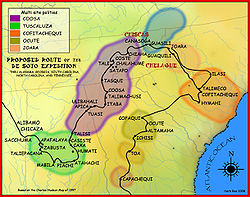
Cofitachequi
Encyclopedia

Paramount chief
A paramount chief is the highest-level traditional chief or political leader in a regional or local polity or country typically administered politically with a chief-based system. This definition is used occasionally in anthropological and archaeological theory to refer to the rulers of multiple...
encountered by the Hernando de Soto Expedition in South Carolina
South Carolina
South Carolina is a state in the Deep South of the United States that borders Georgia to the south, North Carolina to the north, and the Atlantic Ocean to the east. Originally part of the Province of Carolina, the Province of South Carolina was one of the 13 colonies that declared independence...
. They encountered the Chiefdom of Cofitachequi in April of 1540, at the Mulberry Site, a large mound
Platform mound
A platform mound is any earthwork or mound intended to support a structure or activity.-Eastern North America:The indigenous peoples of North America built substructure mounds for well over a thousand years starting in the Archaic period and continuing through the Woodland period...
at the junction of Pine Tree Creek and the Wateree River
Wateree River
The Wateree River, about 75 mi long, is a tributary of the Santee River in central South Carolina in the United States, which flows to the Atlantic Ocean...
, near present-day Camden
Camden, South Carolina
Camden is the fourth oldest city in the U.S. state of South Carolina and is also the county seat of Kershaw County, South Carolina, United States. The population was an estimated 7,103 in 2009...
. A woman the chroniclers call the Lady of Cofitachequi was carried from the town to the river's edge on a litter that was covered with a delicate white cloth. They considered her the "chieftainness" of the villages. After spending several weeks in the village, the Spaniards took the "Lady" and headed to the next chiefdom to the northwest, Joara
Joara
Joara was a large Native American settlement, a regional chiefdom of the Mississippian culture, located in what is now Burke County, North Carolina. Joara is notable as a significant archaeological and historic site. It was a place of encounter in 1540 between the Mississippian people and the...
.
They reported the people of the chiefdom to speak a Muskogean language, although the Chiefdom of Cofitachequi is the easternmost extent of this language family. There were three levels of political power at Cofitachequi. The orata was a lesser noble
Village head
The village headman or village chief is a central government post. The village headman is the person appointed to administer an area that is often a single village.The headman has several official duties in the village...
, seemingly in charge a village or a few villages. The mico was a great noble
Tribal chief
A tribal chief is the leader of a tribal society or chiefdom. Tribal societies with social stratification under a single leader emerged in the Neolithic period out of earlier tribal structures with little stratification, and they remained prevalent throughout the Iron Age.In the case of ...
who occupied one of the administrative centers of the chiefdom, presumably complete with a mound. Above these was the gran cacique, the great chief or paramount chief
Paramount chief
A paramount chief is the highest-level traditional chief or political leader in a regional or local polity or country typically administered politically with a chief-based system. This definition is used occasionally in anthropological and archaeological theory to refer to the rulers of multiple...
. Lesser officials were ynihas, or ynanaes, who were chiefs' assistants, perhaps comparable to magistrates. The yatikas were interpreters and spokesmen. The culture of Cofitachequi was a variant of Lamar culture that was broadly comparable to the people of Ocute.
Other sites and personages encountered by the De Soto Expedition
- List of sites and peoples visited by the Hernando de Soto Expedition
- Mississippian cultureMississippian cultureThe Mississippian culture was a mound-building Native American culture that flourished in what is now the Midwestern, Eastern, and Southeastern United States from approximately 800 CE to 1500 CE, varying regionally....
- Southeastern Ceremonial ComplexSoutheastern Ceremonial ComplexThe Southeastern Ceremonial Complex is the name given to the regional stylistic similarity of artifacts, iconography, ceremonies, and mythology of the Mississippian culture that coincided with their adoption of maize agriculture and chiefdom-level complex social organization from...

